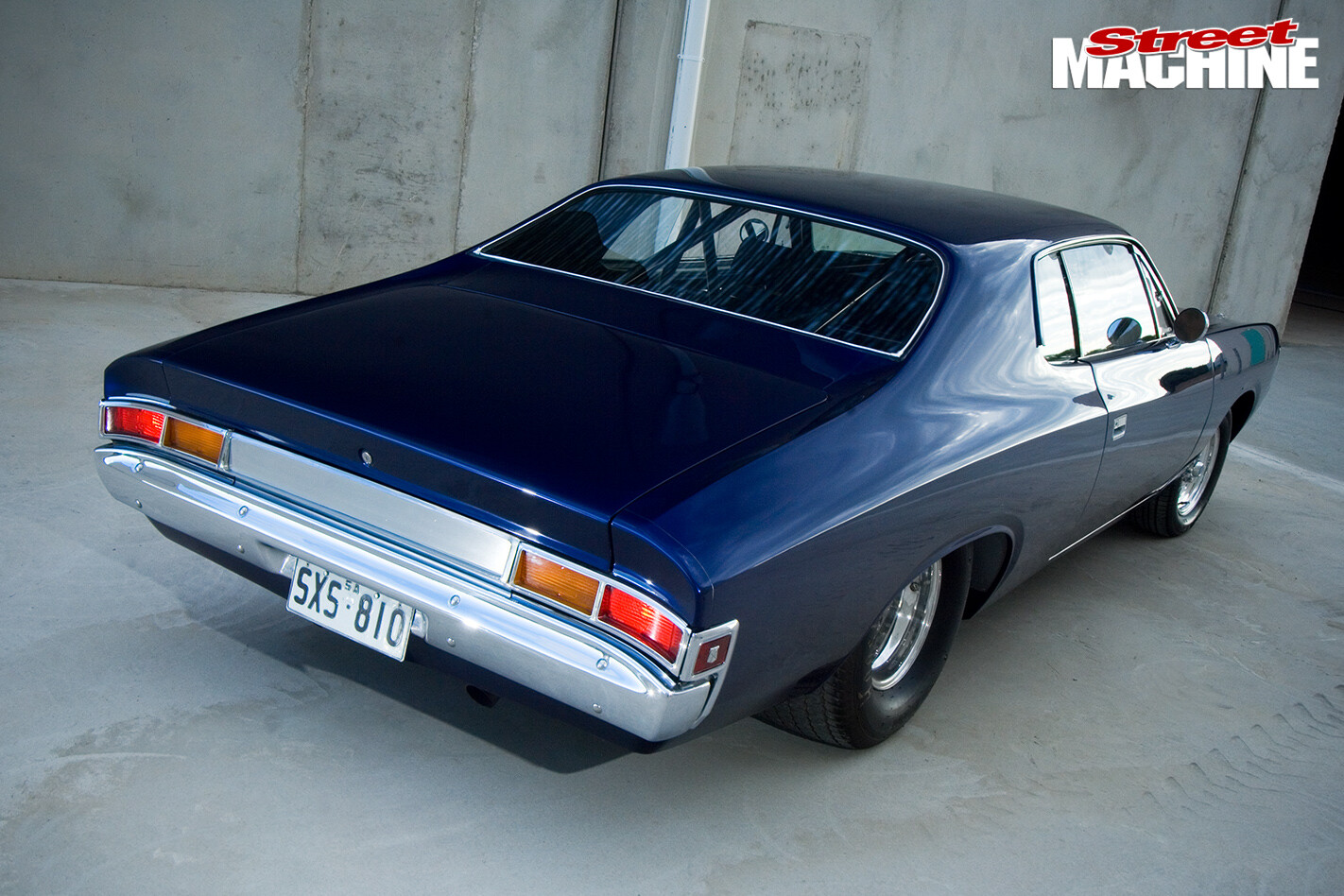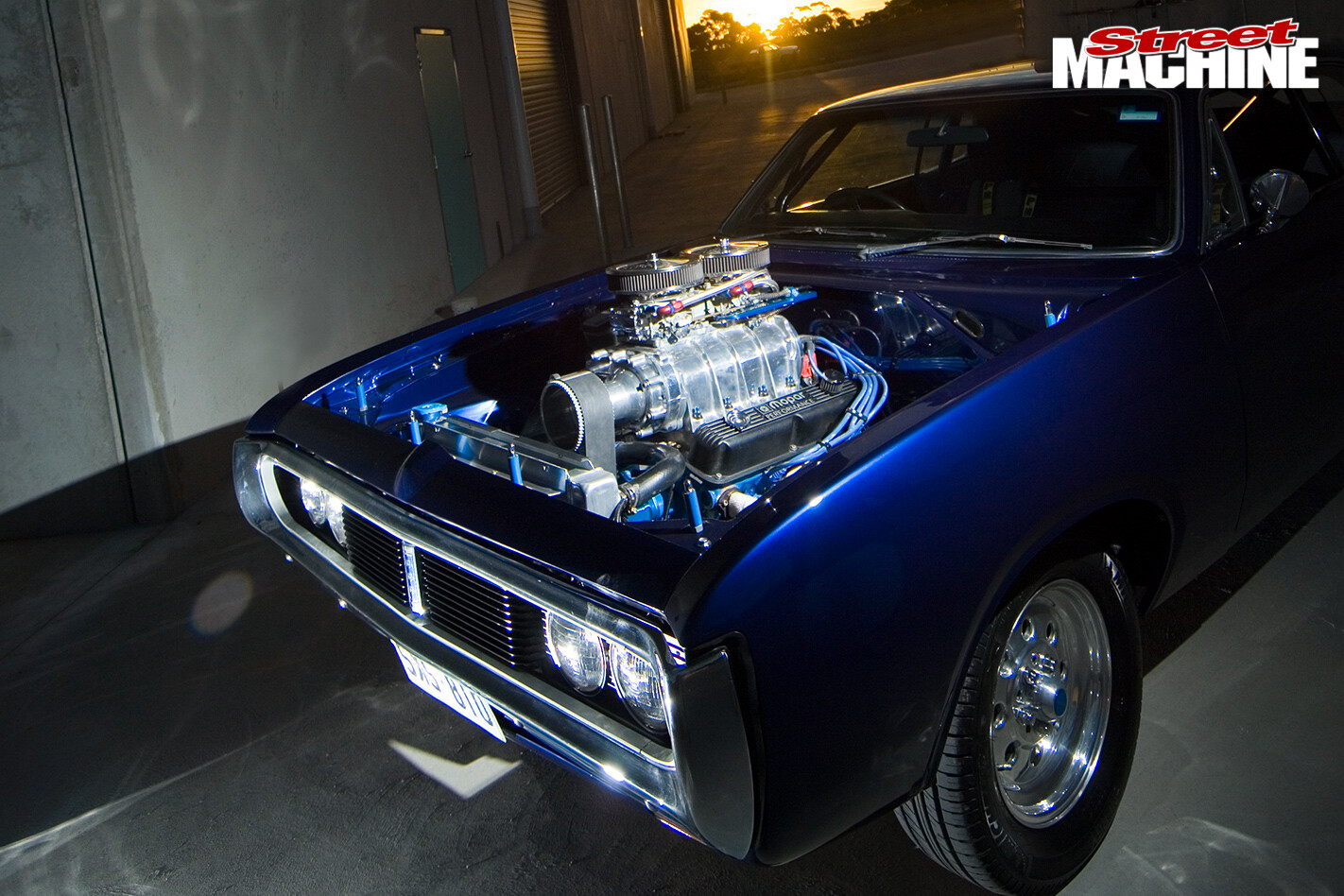After 15 years in the build, it all came down to one special day.
This article was originally published in the August 2007 issue of Street Machine.
Building a cool streeter doesn’t have to be a wham-bam-thank-you-ma’am experience; if you want the job done right, it’s probably better that you take your time.
We always hear these stories of guys building a car in four weeks, but that usually involves throwing a whole bunch of cash at the thing, and hoping it all comes together.
South Australia’s Dave Guger didn’t whip up this beaut Val in a few weeks – finances demanded that he take his time with it, and once it was finished, it was fit to transport him and his blushing bride away to their wedding reception.
 It was a double-your-pleasure experience – new wife, new car, and 406 cubes of blown Chrysler under his right foot. “The reception was 17km away,” Dave recalls, “but I reckon it was the shortest drive of my life. I smoked it up going out on to the main drag from the property, in my first burnout in the two-door, and I had a smile from ear to ear.”
It was a double-your-pleasure experience – new wife, new car, and 406 cubes of blown Chrysler under his right foot. “The reception was 17km away,” Dave recalls, “but I reckon it was the shortest drive of my life. I smoked it up going out on to the main drag from the property, in my first burnout in the two-door, and I had a smile from ear to ear.”
We’d be smiling, too, if we’d just finished a project that signified the end of 15 years’ worth of spent pay cheques and bruised knuckles.
“I bought the car in around ’93, after chasing one for about a year. I was still living with my parents; when I got it home, they thought I was crazy, and couldn’t understand why I had taken on such a big project.” Back then, Dave was an apprentice spray painter, and not exactly drowning in money. As he says, “It took a while to get things started.”
 Chrysler aficionados will be thinking this big coupe is one of the ultra-rare CH Chrysler by Chrysler hardtops built back in the early 70s. They were designed to be full-on, two-door luxury barges with 360-cube small-blocks, and power everything, but fewer than 500 of those babies hit the streets in two-door form.
Chrysler aficionados will be thinking this big coupe is one of the ultra-rare CH Chrysler by Chrysler hardtops built back in the early 70s. They were designed to be full-on, two-door luxury barges with 360-cube small-blocks, and power everything, but fewer than 500 of those babies hit the streets in two-door form.
But it isn’t – the giveaway is its back window. Chrysler by Chrysler hardtops have a smaller back window than the normal VH hardtops. What Dave has done is to bolt on the CH (that’s the model designation for the CxC hardtop) front sheet metal, and graft in the wraparound taillights for the luxo-barge look.
“When I initially picked up the car, it took me three trips with the trailer, it was in so many pieces. The car was an empty shell, and the previous owner had put a BMW sunroof in it, and his own home-made mini tubs.”
So, you can kind of understand Dave’s parents’ concern when they saw the new project.
At the time, Dave had enough money to buy the wheels and tyres he wanted, so he decided to build the car around them. Cutting the rear half of the floorpan out was a pretty big move, but with enough money saved, he shipped the hardtop off to Walker Chassis for a new half chassis, ladder-bar rear end, and rollcage.
Some time later, Dave finished his apprenticeship, and started work at a new crash shop where the boss let him play with the hardtop in his spare time.
“By ’96, the car was completely resprayed inside and out, and its trim work was done,” says Dave. “Not long after this, I bought my first house and then most of my wage was spent on paying a mortgage, so the car went into storage.”
That’s the way the hardtop sat for a long time. Most of the hard work was done, with the minor rust repaired, the new roof skin welded in, and the rear wheelarches stretched 4in on either side to make room for the 31in-tall tyres. Iris Blue – a ’96 Porsche colour – coated the whole deal, but with no money to continue, the big Chrysler waited until the beginning of 2006 before Dave was ready to seal the deal ‑ in more ways than one.
You see, Dave was now betrothed to his fiancée Natasha, and he wanted to complete the hardtop in time for the big day. Eight months was all he had to finish the job – so much for taking his time.
“I started with the diff centre, and worked my way forward on the car to build up the driveline,” Dave reckons. Filled with all the good stuff, the nine-inch rear has everything it needs to handle a blown small-block: full-floating 35-spline axles, a Strange carrier with aluminium pinion support, and 4.56 gears to work those very large rear tyres. Travelling forward to the other end of the custom tailshaft, you’ll find a reverse-pattern, full-manual 727 Torqueflite, and a 3000rpm converter.
 Even Blind Freddie could see what’s up front – 406 cubes of singing small-block makes one hell of a visual statement. To get the right displacement happening, Dave installed a 4in-stroke Eagle steel crank, Scat H-beam rods and custom JE forgings. He also slotted in a very healthy solid-roller camshaft with 0.672in of lift, and topped the mill off with a pair of ported factory ‘J’ heads.
Even Blind Freddie could see what’s up front – 406 cubes of singing small-block makes one hell of a visual statement. To get the right displacement happening, Dave installed a 4in-stroke Eagle steel crank, Scat H-beam rods and custom JE forgings. He also slotted in a very healthy solid-roller camshaft with 0.672in of lift, and topped the mill off with a pair of ported factory ‘J’ heads.
Before the introduction of 4in-throw stroker cranks, it was pretty rare to find a stroked Chrysler small-block, but these days everyone is having a go. The word is out – cubic inches make easy horsepower. Something else that makes easy horsepower is the nice shiny GM blower sitting front and centre. The manifold is a Max Wedge Performance unit which sits the blower pretty low in the valley – those twin 600s are all that’s visible north of the bonnet line.
“I haven’t had time to put it on the dyno yet,” Dave reckons, but we know the blown small-block should be making a healthy dose of power.
“As for its quarter-mile times, we will find them out when Adelaide International Raceway opens [again], and I can get it tuned a bit better,” says Dave, “that’s something I’m really looking forward to.”





Comments